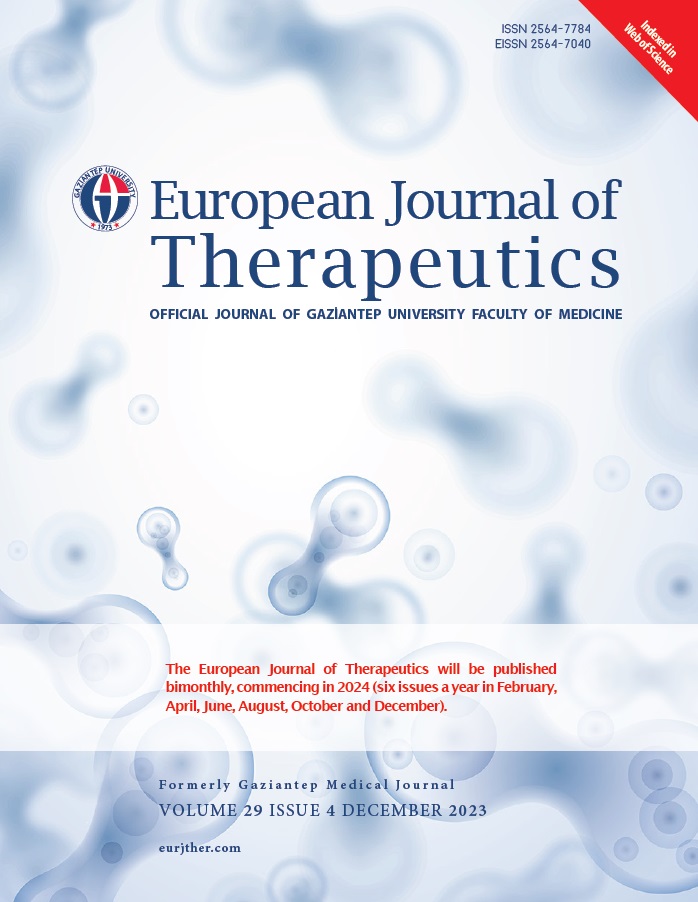The Effect of Biogel Using Biomagnetic Energy in the Treatment of Acute Pain in the Upper Extremity and Spine: A Randomized Controlled Trial
DOI:
https://doi.org/10.58600/eurjther1820Keywords:
Pain, Biogel, Complementary Medicine, Traditional Medicine, Integrative MedicineAbstract
Objective: Pain is a public health problem, which is caused by various etiological factors and leads to diminished quality of life and decreased workforce. The aim of this study was to determine whether Biogel has an effect in the treatment of pain.
Methods: Patients due to acute pain in the upper extremity and/or trunk were divided into two groups as treatment and placebo by randomization method. For the patients in the treatment group,the non-interventional Biogel was applied for 10 minutes. For the control group, a non-interventional placebo was applied for 10 mins. A record was made of patient demographic data,the region of the pain, and mean arterial pressure (MAP) values before and after the application. All the patients in both groups were administered a Visual Analogue Scale (VAS) to evaluate pain severity,and the Nottingham Health Profile (NHP) before and after the applications. The data obtained were compared.
Results: In the biogel group, a statistically significant decrease was determined in the NHP-P values after treatment compared to before treatment (P<0.001). In the placebo group,no statistically significant difference was determined in the NHP-P values before and after treatment (P=0.104). In the Biogel group,a statistically significant decrease was determined in the VAS values after treatment compared to before treatment (P<0.001). In the placebo group,no statistically significant difference was determined in the VAS values before and after treatment (P=0.157).
Conclusion: These types of complementary medicine applications focussed on pain treatment can reduce the disease burden and can probably reduce costs.
Metrics
References
Alcock MM (2017) Defining pain: past, present, and future. Pain. 158:761-762. https://doi.org/10.1097/j.pain.0000000000000828
Raja SN, Carr DB, Cohen M, Finnerup NB, Flor H, Gibson S, Keefe FJ, Mogil JS, Ringkamp M, Sluka KA, Song XJ, Stevens B, Sullivan MD, Tutelman PR, Ushida T, Vader K (2020) The revised International Association for the Study of Pain definition of pain: concepts, challenges, and compromises. Pain. 161:1976-1982. https://doi.org/10.1097/j.pain.0000000000001939
Grichnik KP, Ferrante FM (1991) The difference between acute and chronic pain. Mt Sinai J Med. 58:217-220.
Pittler MH, Brown EM, Ernst E (2007) Static magnets for reducing pain: systematic review and meta-analysis of randomized trials. CMAJ. 177:736-742. https://doi.org/10.1503/cmaj.061344
Kumar KH, Elavarasi P (2016) Definition of pain and classification of pain disorders. Journal of Advanced Clinical and Research Insights. 3:87-90. https://doi.org/10.15713/ins.jcri.112
World Health Organization (2000). General Guidelines for Methodologies on Research and Evaluation of Traditional Medicine. Geneva: WHO Books;80.
Koşalay I (2014) Elektromanyetik Alanlar ve Bioenerji Olgusu. Pamukkale Univ Muh Bilim Derg. 20:287-293. https://doi.org/10.5505/pajes.2014.36854
Oschman JL (2002) Science and Human Energy Field. Reiki News Magazine. 3:27-44.
Oğuz M (2017) Hastalıkların Duygusal Sebepleri ve Mental Tedavi. Ankara: Hayat Yayınları, pp 26
Sherwood K (2017) Ruhsal Şifa Teknikleri, çev. Semra Ayanbaşı. İstanbul: Akaşa Yayıncılık, pp 8
Erdoğan Z, Çınar S (2011) Reiki: Eski Bir İyileștirme Sanatı – Modern Hemșirelik Uygulaması. Kafkas J Med Sci. 1:86-91. https://doi.org/10.5505/kjms.2011.70288
Şuayip Dağıstanlı (2010) Biyoenerji. İstanbul: Dharma Yayınları, pp 103
Özdağ N, Mollahaliloğlu S, Öztaş D, Bozcuk Güzeldemirci G (2015) Ağrı tedavisinde akupunkturun yeri. Ankara Med J. 15:249-253. https://doi.org/ 10.17098/amj.43740
Ay S, Tur BS, Evcik D (2019) Kas iskelet sistemi hastalıklarında sık uygulanan geleneksel ve tamamlayıcı tıp uygulamaları. Kocatepe Tıp Dergisi. 20:147-156.
http://www.biogely.com/ (Date of access: 10.01.2023)
https://www.randomizer.org/ (Date of access: 13.01.2023)
Hunt SM, McKenna SP, McEwen J, Backett EM, Williams J, Papp E (1980) A quantitative approach to perceived health status: a validation study. J Epidemiol Community Health. 34:281-286. https://doi.org/10.1136/jech.34.4.281
Kücükdeveci AA, McKenna SP, Kutlay S, Gürsel Y, Whalley D, Arasil T (2000) The development and psychometric assessment of the Turkish version of the Nottingham Health Profile. International journal of rehabilitation research. Int J Rehabil Res. 23:31-38. https://doi.org/10.1097/00004356-200023010-00004
McMahon S, Koltzenburg M, Tracey I, Turk DC (2013) Wall & melzack's textbook of pain e-book. Elsevier Health Sciences.
https://www.cdc.gov/mmwr/volumes/67/wr/mm6736a2.htm?s_cid=mm6736a2_w (Date of access: 11.01.2023)
Kuehn B (2018) Chronic Pain Prevalence. JAMA. 320:1632. https://doi.org/10.1001/jama.2018.16009
Sá KN, Moreira L, Baptista AF, Yeng LT, Teixeira MJ, Galhardoni R, de Andrade DC (2019) Prevalence of chronic pain in developing countries: systematic review and meta-analysis. Pain Rep. 4:e779. https://doi.org/10.1097/PR9.0000000000000779
Gregory J, McGowan L (2016) An examination of the prevalence of acute pain for hospitalised adult patients: a systematic review. J Clin Nurs. 25:583-598. https://doi.org/10.1111/jocn.13094
Holcomb R (1991) Biomagnetics in the treatment of human pain-past, present, future. Environ Med. 8:24-30.
Jerabek J, Pawluk W (1998). Magnetic therapy in Eastern Europe: a review of 30 years of research, 2nd edn, Paperback Publishers, Philadelphia
Funk RHW, Fähnle M (2021) A short review on the influence of magnetic fields on neurological diseases. Front Biosci (Schol Ed). 13:181-189. https://doi.org/10.52586/S561
Paolucci T, Pezzi L, Centra AM, Giannandrea N, Bellomo RG, Saggini R (2020) Electromagnetic Field Therapy: A Rehabilitative Perspective in the Management of Musculoskeletal Pain - A Systematic Review. J Pain Res. 13:1385-1400. https://doi.org/10.2147/JPR.S231778
National center for complementary and integrative health (NCCIH): Magnets For Pain: What You Need To Know: https://www.nccih.nih.gov/health/magnets-for-pain-what-you-need-to-know (Date of access: 11.01.2023)
Prato FS, Carson JJ, Ossenkopp KP, Kavaliers M (1995) Possible mechanisms by which extremely low frequency magnetic fields affect opioid function. FASEB J. 9:807–814. https://doi.org/10.1096/fasebj.9.9.7601344
Del Seppia C, Ghione S, Luschi P, Ossenkopp KP, Choleris E, Kavaliers M (2007) Pain perception and electromagnetic fields. Neurosci Biobehav Rev. 31:619-642. https://doi.org/10.1016/j.neubiorev.2007.01.003
Downloads
Published
How to Cite
Issue
Section
Categories
License
Copyright (c) 2023 European Journal of Therapeutics

This work is licensed under a Creative Commons Attribution-NonCommercial 4.0 International License.
The content of this journal is licensed under a Creative Commons Attribution-NonCommercial 4.0 International License.


















